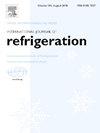Experimental investigation and physics-informed neural network based modelling of heat transfer coefficient and pressure drop in R513A flow boiling through micro-fin tube
IF 3.5
2区 工程技术
Q1 ENGINEERING, MECHANICAL
International Journal of Refrigeration-revue Internationale Du Froid
Pub Date : 2025-01-25
DOI:10.1016/j.ijrefrig.2025.01.025
引用次数: 0
Abstract
This research investigates the heat transfer coefficient (HTC) and frictional pressure drop (FPD) during flow boiling of refrigerant R513A in a micro-fin tube under varying operational conditions. The primary goal is to enhance understanding of flow boiling characteristics to improve heat exchanger designs for environmentally friendly refrigerants. Experimental analysis was conducted using a 1000 mm-long tube with an outer diameter of 9.52 mm, considering heat flux (12–36 kW·m⁻²), vapor quality (0.02–0.96), mass flux (50–300 kg·m⁻²·s⁻¹), and saturation temperature (290.15–300.15 K). A Physics-Informed Neural Network (PINN) model was developed to predict HTC and FPD using these operational parameters as inputs, integrating experimental data with physical constraints for enhanced prediction accuracy. The PINN architecture, comprising 4-64-128-64-2 neurons, was optimized through systematic hyperparameter tuning, achieving well-converged training and validation losses. Key findings reveal the significant impact of heat flux, mass flux, and vapor quality on HTC and FPD, with micro-fin geometries enhancing heat transfer efficiency. This study bridges experimental data with advanced predictive modeling, offering a novel framework for optimizing thermal systems using sustainable refrigerants. The results provide valuable insights for designing high-efficiency, environmentally sustainable cooling systems.
求助全文
约1分钟内获得全文
求助全文
来源期刊
CiteScore
7.30
自引率
12.80%
发文量
363
审稿时长
3.7 months
期刊介绍:
The International Journal of Refrigeration is published for the International Institute of Refrigeration (IIR) by Elsevier. It is essential reading for all those wishing to keep abreast of research and industrial news in refrigeration, air conditioning and associated fields. This is particularly important in these times of rapid introduction of alternative refrigerants and the emergence of new technology. The journal has published special issues on alternative refrigerants and novel topics in the field of boiling, condensation, heat pumps, food refrigeration, carbon dioxide, ammonia, hydrocarbons, magnetic refrigeration at room temperature, sorptive cooling, phase change materials and slurries, ejector technology, compressors, and solar cooling.
As well as original research papers the International Journal of Refrigeration also includes review articles, papers presented at IIR conferences, short reports and letters describing preliminary results and experimental details, and letters to the Editor on recent areas of discussion and controversy. Other features include forthcoming events, conference reports and book reviews.
Papers are published in either English or French with the IIR news section in both languages.

 求助内容:
求助内容: 应助结果提醒方式:
应助结果提醒方式:


